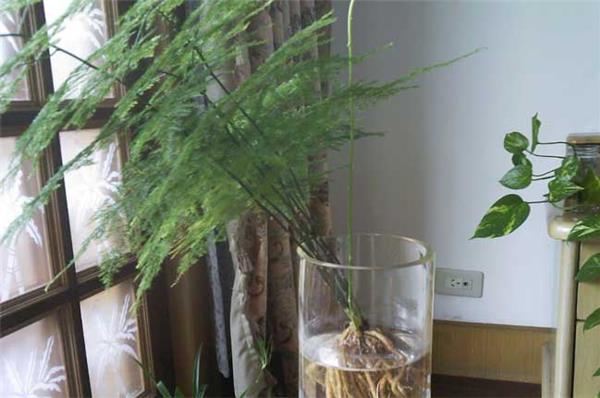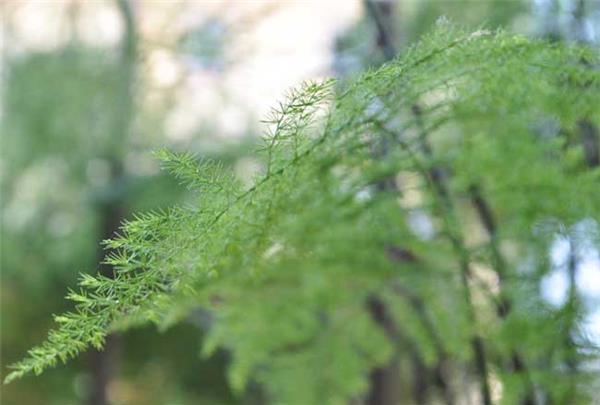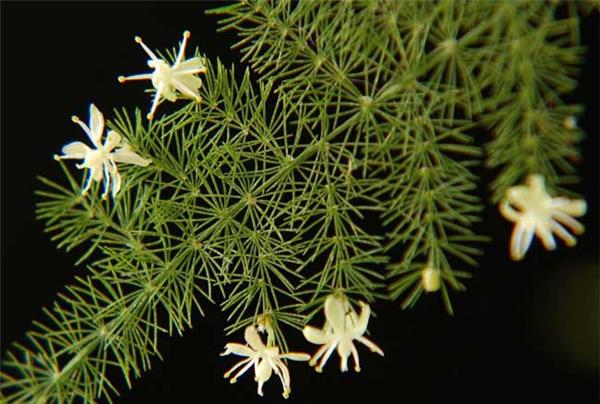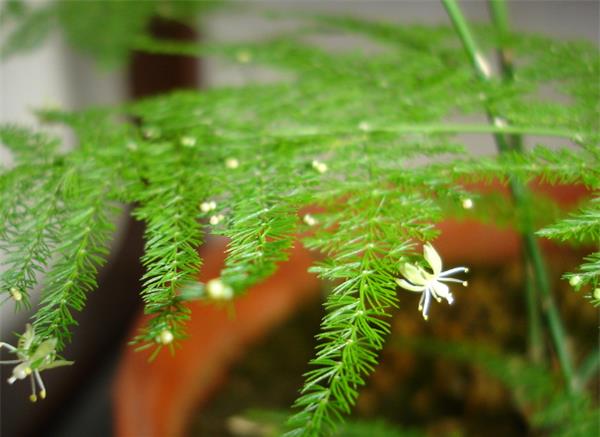Introduction to cultivation and management techniques of asparagus
Asparagus belongs to Liliaceae, Tianmen winter genus, specially used for cutting leaves and small potted plants, pot ornamental elegant and generous, as an important ingredient of cut flowers, the commodity rate is very high. Because of its strong adaptability, simple cultivation and management and less gardening, it can be produced by using the land at the edge, corner and corner of the greenhouse, so it has a bright future.

Morphological characteristics
Asparagus is a perennial herbaceous climbing plant. The stem is clustered from the rhizome. Many branches, horizontal development, the shape is similar to triangle, the edge is often wavy, the surface is green, there are most small white spots, dark red on the back. Flowers and stalks are deep purplish red, clustered and drooping. The berries are globose, purple-black when ripe, and contain 1-3 seeds. Common cultivation of asparagus (var.nanus) is a variety of asparagus, the plant is shorter, stems clump, erect, not climbing, leafy branches are more dense.

Ecological habit
Native to southern Africa, like warm and humid environment. Afraid of strong light and low temperature, sunshade is needed in summer, and the temperature in winter is not lower than 5C. Soil to loose and fertile humus soil is the most suitable, planting asparagus should choose good drainage, loose and fertile sandy soil, avoid stagnant water. The winter temperature should be kept at 12C~15C, not lower than 8C.

Reproduction method
The method of propagation of asparagus generally uses seed sowing, and it is also feasible to propagate separately, but the plant propagated by ramet has a partial crown and irregular shape at the initial stage.
1. Sowing and propagation: asparagus berries mature one after another in winter. When the berries turn purple-black, they can be harvested. After the berries are harvested, rub the exocarp to remove the seeds. Rinse and sow the seeds. If the room temperature is less than 15C, you should wait until spring is warm before sowing, during which sand storage and sowing should be carried out, mainly indoor pot sowing, generally sowing in a shallow basin with a grain distance of two centimeters, and covering the soil should not be too deep. Cover it with glass or film after soaking in water to reduce water evaporation, keep the basin soil moist, and place it in a sunny place. After sowing, the temperature is about 20C, and it can germinate in 25 ~ 30 days, but it takes 30 ~ 40 days to germinate in 15C~18C. When the seedlings grow to 3 ~ 4 meters high, they can be divided and transplanted.
2. Ramet propagation: when changing pots in spring, peel away the roots, do not hurt too many roots, and plant in pots or on the ground according to plant size. After planting, pour water thoroughly, put it in a semi-shaded place or line to shade. Watering should be properly controlled in the future, otherwise it is easy to cause yellow leaves.

Cultivation techniques
1. The key to asparagus management is watering. Watering too often, branches and leaves are easy to yellowing, poor growth, easy to cause rotten roots. The amount of water should be adjusted according to plant growth and season. In winter, spring and autumn, watering should be properly controlled. Generally, the surface of the basin soil is dry and then irrigated. If you feel that it is difficult to grasp the amount of water, you can also take the alternation of large and small water. That is, after 3 or 5 times of small water, pour water once, so that the basin soil remains moist and does not contain much water. It should be watered in the morning and evening in summer, and it doesn't matter if the amount of water is a little larger.
2. Although asparagus does not like fertilizer very much, it should be supplemented with more nutrients when potted, especially the plants that are going to keep seeds. The fertilization of asparagus should be thin and diligent, and thick fertilizer should not be used. The rotten organic liquid fertilizer is generally applied every 15 to 20 days in the growing season. Asparagus likes slightly acidic soil. Therefore, it can be combined with fertilization, appropriate application of some alum fertilizer and water to improve soil acidity and alkalinity.
3. Asparagus should spend the winter indoors, and the room temperature should be kept at about 10C in winter, and enough light should be given, so that it can be moved to outdoor maintenance after April next year. Asparagus planted in the ground, with luxuriant branches and leaves, and rapid growth of new vines, must be set up in time to facilitate ventilation and light. Proper pruning of dead branches and old vines to promote the germination of new vines. Apply bone powder or superphosphate once before flowering to improve the seed setting rate. As a cutting asparagus, the branches that meet the requirements of listing are cut at the root during harvest, and every 20 branches are bandaged and listed on the market, and the price in winter is generally more than 20% higher than that in summer and autumn.
This is the end of the introduction to the cultivation and management techniques of asparagus. I hope it will be helpful to you.
Related
- Wuhan Hospital Iron Tree Blooming Result Was Instantly Frightened by the Gardener Master
- Which variety of camellia is the most fragrant and best? Which one do you like best?
- What is the small blue coat, the breeding methods and matters needing attention of the succulent plant
- Dormancy time and maintenance management of succulent plants during dormancy
- Minas succulent how to raise, Minas succulent plant pictures
- What are the varieties of winter succulent plants
- How to raise succulent plants in twelve rolls? let's take a look at some experience of breeding twelve rolls.
- Attention should be paid to water control for succulent plants during dormant period (winter and summer)
- Watering experience of twelve rolls of succulent plants
- Techniques for fertilizing succulent plants. An article will let you know how to fertilize succulent plants.



